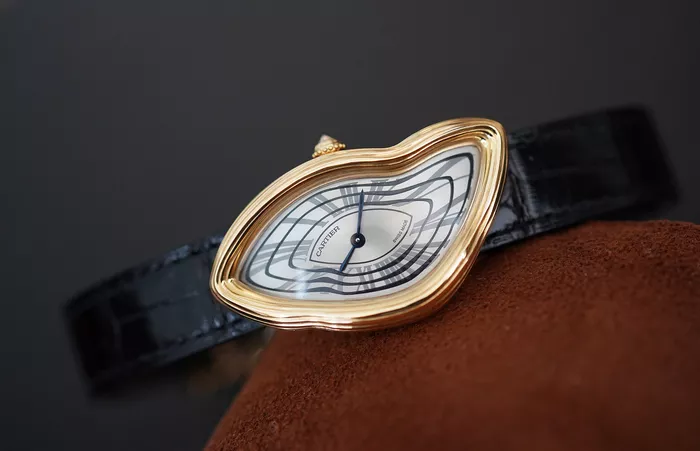The Cartier Crash, an emblem of avant-garde watchmaking, has come full circle since its inception in 1967. Originating during an era of countercultural upheaval, this timepiece has recently experienced a renaissance, finding favor among celebrities and collectors alike.
A Surreal Origin
The Cartier Crash’s genesis is shrouded in intrigue. The watch’s creation is attributed to Jean-Jacques Cartier and designer Rupert Emmerson, who aimed to encapsulate the surrealism and rebellious spirit of the late 1960s. The popular narrative suggests the design was inspired by a Cartier Baignoire watch damaged in a car accident—a story that blends myth with marketing allure. In reality, the Crash was born from a desire to challenge conventional aesthetics, producing a watch that defied traditional norms.
Design and Impact
Distinct in its design, the Crash features an asymmetrical, melted appearance reminiscent of Salvador Dali’s “The Persistence of Memory,” with its warped dial and case seemingly scorched by intense heat. This unusual form, highlighted by curved Roman numerals, creates a timepiece that is both unsettling and captivating. It stands as a testament to the art of imperfection and the celebration of the unconventional.
A Resurgence in Popularity
Initially a rare gem appreciated by horological connoisseurs, the Cartier Crash has gained significant traction in recent years. This resurgence is attributed to its endorsement by high-profile celebrities, reflecting a broader luxury market trend where rarity and uniqueness are highly valued. The Crash’s limited production and distinctive design have positioned it as a coveted item.
Recent public appearances have amplified its status. Twitch streamer Kai Cenat’s display of a vintage Crash on his livestream and LeBron James’s courtside flaunting of a $300,000 Crash Skeleton have turned the timepiece into a cultural symbol. These endorsements underscore the Crash’s evolution from a niche collectible to a prominent luxury statement.
Is the Crash at Its Peak?
Despite its renewed prominence, some enthusiasts question whether the Cartier Crash has reached its zenith. The watch’s increasing visibility and soaring auction prices have led to concerns that it may be losing some of its original mystique. As it transitions from a rare find to a hot commodity, there is a risk it could become too mainstream, potentially diminishing its unique appeal.
Influence and Legacy
The Crash’s revolutionary design has inspired numerous imitations, with the Exaequo Softwatch being a notable example. Introduced in 1990, the Softwatch extended the surrealism popularized by Dali. Although it faced legal challenges for using Dali’s signature, it has gained attention for its innovative design. Like the Crash, the Softwatch has seen a revival in popularity, reflecting the enduring impact of Cartier’s design on the watchmaking world.
The Softwatch, with its accessible yet distinctive appeal, serves as an alternative to the Cartier Crash, showcasing how influential designs continue to shape the market. Despite differences in prestige, it underscores the Crash’s lasting influence on horological artistry.
In conclusion, while the Cartier Crash has undeniably reached new heights in popularity, its journey from a quirky piece to a mainstream icon highlights the cyclical nature of luxury and design. As it continues to capture imaginations and adorn wrists, the Crash remains a symbol of innovation and artistic expression in the world of watchmaking.

